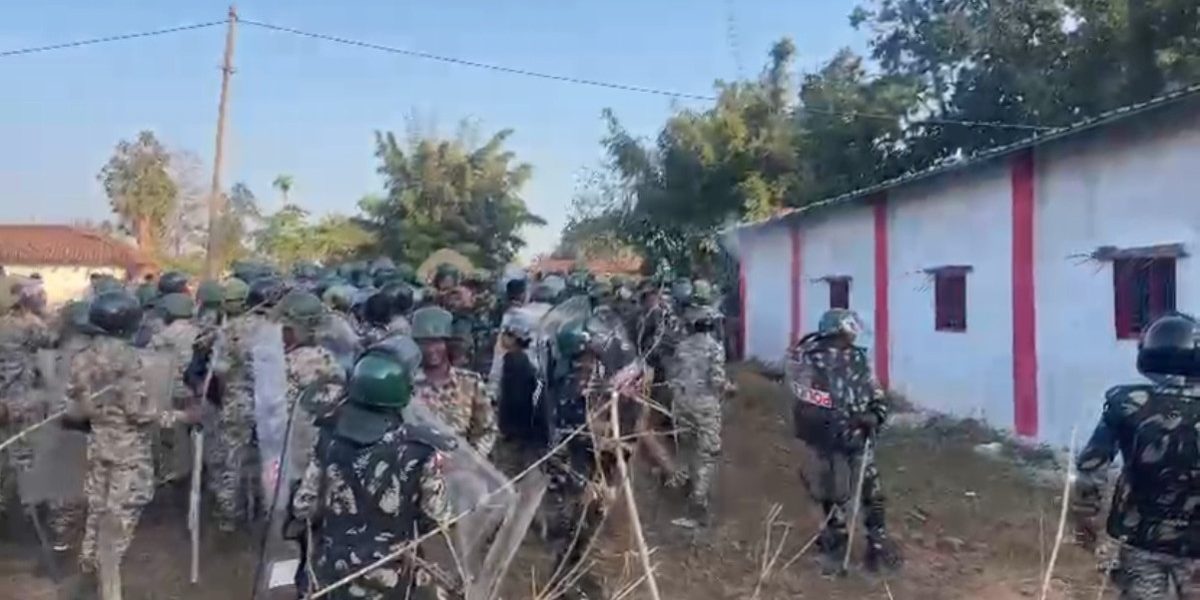
New Delhi: Since Adityanath assumed office as chief minister of Uttar Pradesh in 2017, 48 journalists have been physically assaulted in the state and 66 have been booked or arrested, a report published by the Committee Against Assault on Journalists has found.
Seventy eight percent of such cases were recorded during the pandemic in 2020 and 2021 alone.
The CAAJ report, titled ‘The Siege of the Media,’ offers details of incidents related to the suppression of press freedom in Uttar Pradesh, based on statistics and figures gathered between 2017 and the present day.
According to the report, a total of 138 cases of persecution of journalists were registered in Uttar Pradesh between 2017 and February 2022.
CAAJ claims that the report, prepared in collaboration with the Uttar Pradesh People’s Union for Civil Liberties (UP PUCL), includes only those cases which have been verified at the grassroots level. Therefore, the numbers may be fewer than the actual count of such incidents.
Twelve journalists killed
Based on the nature of attacks, the report has been divided into four categories – ‘murder’, ‘physical assault’, ‘trial or arrest’ and ‘custody or threat or espionage’.
Since the time Adityanath was sworn in as the chief minister in 2017 till the publication of the CAAJ report, a total of 12 journalists have been killed in the state, 48 physically assaulted, and 66 were booked under various charges or arrested. Twelve cases of intimidation, detention or spying have also been reported.
During the BJP’s five-year term in Uttar Pradesh, 78% of the cases (109) were recorded during the pandemic – 52 in 2020 and 57 in 2021.
Seven journalists were killed in 2020, the highest for a year.
Soon after the BJP came to power in 2017, two journalists – Naveen Gupta of Hindustan newspaper in Kanpur’s Bilhaur, and Rajesh Mishra who was a Dainik Jagran journalist in Ghazipur – were shot dead.
According to the report, no journalists were killed in 2018 and 2019, but in 2020, a total of seven journalists – Rakesh Singh, Suraj Pandey, Uday Paswan, Ratan Singh, Vikram Joshi, Faraz Aslam and Shubham Mani Tripathi – were murdered.
Rakesh Singh, associated with Rashtriya Swaroop, a local newspaper, was killed after his house was attacked and set on fire in Balrampur, allegedly for him exposing corruption.
An Unnao-based journalist Shubham Mani Tripathi sought police protection after he received threats for exposing the sand mafia. However, he was shot dead before his request was addressed.
Vikram Joshi was gunned down in broad daylight in Ghaziabad while TV journalist Ratan Singh was also shot dead in Ballia. Another journalist, Uday Paswan and his wife were beaten to death by gangsters in Sonbhadra’s Barwadih village.
In Unnao, a journalist with a local English daily, Suraj Pandey, was found dead under suspicious circumstances on a railway track. While the police called it a suicide, the victim’s family alleged that it was murder. A sub-inspector and constable were arrested later.
Faraz Aslam, a correspondent of Paigam-e-Dil based in Kaushambi, is believed to have been murdered on the suspicion of being a police informer.
In 2021, the murder of two journalists – Sulabh Srivastava and Raman Kashyap – made headlines across the country.
Srivastava, who exposed the corruption of the local liquor mafia in Pratapgarh, was apprehensive that mafia functionaries might get him killed and even sought police protection before his murder. Instead of taking action, however, the police labelled the murder as an accident. The Editors’ Guild of India had also issued a statement regarding the matter, questioning the working of the UP Police.
Meanwhile, in Lakhimpur Kheri, the son of Union Minister Ajay Mishra, Ashish, allegedly mowed down protesting farmers with his SUV. In the incident, journalist Raman Kashyap was killed.
Examining the matter, an all India investigation team, which also included the PUCL, concluded that it was a well-planned one.
In 2022, journalist Sudhir Saini was allegedly beaten to death in broad daylight in Saharanpur.
The CAAJ report further adds that the actual number of slain journalists during the period might be more than 12.
Most attacks perpetrated by the state and the administration
The report claims that most of the attacks on journalists and press freedom – including legal notices, FIRs, arrests, detention, espionage, threats and violence – have been instigated by the state and the administration.
The list of physical assault incidents is also quite long. At least 50 journalists were attacked or physically assaulted during the past five years. The attackers in these incidents, ranging from minor heckling to fatal assaults, included policemen, politicians, strongmen and common people. Most of the attacks were carried out while the correspondent was on duty.
CAAJ’s UP in-charge Vijay Vineet, who was also the District President of the Working Journalists’ Union (UPWJU), was attacked in November 2019. The attacker is a history-sheeter who was charged 110 times. Vineet was brutally thrashed for opposing illegal encroachment and other criminal activities. His arm was fractured. Vineet has earlier worked for Dainik Jagran and was working as the media in-charge of BJP MLA Bhupesh Choubey at the time of the attack.
According to the report, there was a significant hike in the number of physical assaults in 2020 and the highest number of such attacks were reported in 2021.
One of the most-hyped cases of the year was the heckling of journalists by the security personnel of former chief minister Akhilesh Yadav – a matter in which both the parties registered FIRs.
In another incident, a female Dalit journalist, Muskan Kumari, was stabbed in Lucknow in September 2021.
Another serious attack was carried out on a Saharanpur-based journalist, Devesh Tyagi, in broad daylight, in which a local BJP leader was allegedly involved. In the said case, the FIR was registered against a total of 11 people including the BJP leader.
Manoj Kumar Soni was gravely injured in an assault in Sonbhadra in November 2020. It was the second attack on him. Earlier, he had been assaulted in 2018.
In the second attack in 2020, Soni, who works in the daily Perfect Mission, was beaten by six people with iron rods. He suffered many fractures. Had the police taken action the first time, the incident could have been averted.
According to the CAAJ report, most of the cases in 2021 are related to police harassment. In 2022, cases of physical assault on journalists have so far been reported from Amethi, Kaushambi, Kunda, Sitapur, and Ghaziabad.
Lawsuits filed as vengeance
The CAAJ report claims that 2020 and 2021 were the worst years considering the number of legal cases filed against and notices served to journalists. In every single district in UP, journalists were prosecuted for news coverage.
FIRs were registered by the state government agencies against scribes for reporting even on basic issues such as medical negligence, mismanagement of quarantine centres and non-availability of PPE kits.
The government also filed cases in retaliation against reporters for covering incidents like students being served salt and chapatis in the mid-day meal, children from the Musahar community forced to eat grass during the lock-down, and students being made to mop the school floor.
The police kept harassing regional journalist, Pawan Jaiswal, for reporting on how school children were being served substandard food as mid-day meals, until the Press Council of India stepped in and took cognisance of the matter.
The excesses of the Yogi government against the local daily, Jan Sandesh, which carried the mid-day meal story did not end here as the state government even stopped advertisements to the paper.
A few days later, Santosh Jaiswal, a regional journalist based in Azamgarh, was arrested and imprisoned for exposing the matter of primary school students being forced to clean the school premises on September 7, 2019.
According to the CAAJ report, at least 55 journalists and editors in Uttar Pradesh were booked or arrested for reporting on the worsening COVID-19 situation during the lockdown.
During this period, not only did local or regional correspondents face action, but even prominent journalists were targeted.
The Varanasi district administration got a case filed against Scroll.in editor Supriya Sharma under various sections of the IPC and the SC/ST (Prevention of Atrocities) Act, 1989. A resident of Domari village in Varanasi’s Ramnagar police station area, Mala Devi, was made to lodge a complaint against Sharma alleging that she falsely reported that the situation in the village had deteriorated in the absence of emergency food support during the lockdown.
In her report, Sharma wrote how the condition of locals in Domari, one of the villages adopted by Prime Minister Narendra Modi under the Sansad Adarsh Gram Yojana in 2018, had worsened owing to the lockdown.
Not only were lawsuits filed to cover up administrative mismanagement during the lockdown, but even the families of senior journalists were harassed.
Another such case involves Sanjay Srivastava, editor of Orai-based Young Bharat news portal, who has served as bureau chief in a journalistic career spanning over 35 years. Despite several pleas with the top administration, no cognisance of the injustice meted out to him has been taken so far.
The CAAJ report alludes to a letter by Sanjay Srivastava in which he described how the local collector took offence to one of his reports and dispatched two dozen cops to raid his house. They beat up his family members and resorted to looting.
Similarly, in Fatehpur, the local administration registered a case against Ajay Bhadauria, a senior journalist and president of the District Journalists’ Association.
Charges of criminal conspiracy were slapped on Bhadauria for reporting the closure of the community kitchen run for the poor during the lockdown. Angered with the harassment by the local administration, about a dozen journalists in Fatehpur carried out a ‘jal satyagraha’ by standing in the Ganga river.
The CAAJ report also mentions how correspondents of major news organisations like the BBC and The Hindu had to face litigation from the Uttar Pradesh government.
Meanwhile, the Adityanath government also tried to implicate Delhi-based journalists – The Wire’s founding editor Siddharth Varadarajan, along with Mrinal Pandey, Rana Ayyub, Zafar Agha, Saba Naqvi, Vinod K. Jose, and Anant Nath – in various cases.
The report also notes that The Wire was specifically targeted and raids were carried out on the offices of Bharat Samachar and Dainik Bhaskar.
According to the report, countless notices have been served to journalists in Uttar Pradesh under various Acts and Section 188 of the IPC.
There are yet unreported cases against journalists at the district and block levels, registered during the two lockdowns, the report says. The actual number of cases against journalists over a period of five years in all categories of assault is much more than 138, it notes.
This story first appeared on thewire.in





